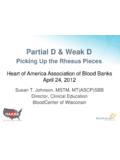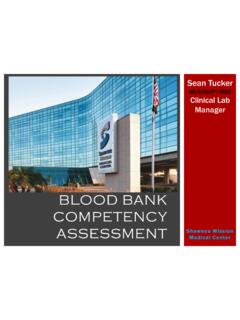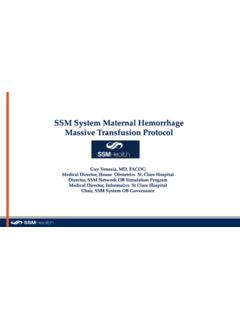Transcription of Serological Interference Caused by Monoclonal Antibody ...
1 Serological Interference Caused by Monoclonal Antibody Drug Therapy Presented by: Christina Barron, MT(ASCP)SBB Prepared by: Christina Barron, MT(ASCP)SBB Monica A. Keith MS, BB(ASCP) Kelly Kezeor MT(ASCP) Monoclonal Antibody Therapeutics Monoclonal antibodies (MoAbs) represent a novel class of therapeutics that are increasingly being integrated into the clinical treatment of solid tumors, leukemia, infections, and cardiovascular and inflammatory diseases. Daratumumab (Darzalex or DARA) is a promising new MoAb therapy for relapsed/refractory multiple myeloma patients. Multiple myeloma is an incurable blood cancer formed by the uncontrollable growth of malignant plasma cells that form tumors primarily in the bone marrow. 1 DARA s mechanism of action DARA is an IgG1 kappa human MoAb that specifically targets human CD38, which is highly expressed on multiple myeloma cells. By attaching to the CD38 protein, DARA acts to directly kill the malignant myeloma cells in addition to assisting the immune system in its attack on these cells.
2 In clinical studies, 29-36% of patients receiving DarzalexTM experienced a complete or partial reduction in their tumor burden. 2 CD38 molecule CD38 is a transmembrane glycoprotein expressed on hematopoietic cells. 3 CD38 It is expressed on many immune cells (white blood cells). It is overly expressed on malignant plasma cells. It is weakly expressed on normal red blood cell membranes. It is absent from pluripotent hematopoietic precursor cells. 4 Daratumumab Since the CD38 protein is highly expressed on myeloma cells, it is an effective target antigen for Monoclonal Antibody therapy. The first commercial therapeutic human anti-CD38 Monoclonal Antibody for treating multiple myeloma was approved by the FDA in November 2015. Daratumumab (DarzalexTM) is manufactured by the Janssen Biotech pharmaceutical company. Daratumumab is also referred to as DARA or anti-CD38 in the literature 5 Daratumumab indications DarzalexTM is indicated for multiple myeloma patients who have received at least three prior lines of therapy (late-stage).
3 Patients are pre-medicated with corticosteroids, antipyretics, and antihistamine. The recommended administration schedule is: weekly for 8 weeks, followed by every 2 weeks for 16 weeks, and then ending with every four weeks until disease progression. 6 Mechanism of Action DARA binds to CD38 on multiple myeloma plasma cells and inhibits the growth of the CD38-expressing tumor cells. DARA induces apoptosis directly through Fc mediated cross linking and by immune-mediated tumor cell lysis. DARA promotes apoptosis or growth arrest by: blocking the receptor-ligand interaction Activating apoptotic signaling pathways Targeting and delivering toxins 7 Notification of DARA s impact on Serological testing Both the FDA and AABB have issued a news release/bulletin with an alert that DARA (CD38 Monoclonal antibodies) can result in Interference with Blood Bank serologic testing that can cause delays in issuing red blood cell products to patients receiving DARA.
4 To minimize delays associated with the anti-CD38 Interference , hospitals are being encouraged to clearly identify to the transfusion service the patients who have been prescribed DARA. 8 DARA Interference in Serological testing Since the CD38 glycoprotein is also weakly expressed on red blood cells, DARA binds to the CD38 protein on reagent red blood cells and interferes with pretransfusion testing that incorporates the indirect antiglobulin test (IAT). The binding of DARA to CD38 on reagent and donor red blood cells results in a positive indirect antiglobulin test (IAT) that causes positive reactions in: Antibody detection (screening) tests Antibody identification panels Compatibility testing 9 DARA s Serological impact It can cause agglutination in all media: saline, low ionic strength saline, polyethylene glycol. It can cause agglutination with all IAT methods: tube, Gel, and solid phase. Agglutination is typically weak (w+-1+) but can be stronger (up to 4+) with solid phase testing.
5 DARA does not interfere with ABO/Rh testing or with immediate spin compatibility testing. It could potentially mask the presence of an underlying clinically significant alloantibody. 10 Effects of DARA Adsorptions are ineffective at removing the Interference . The effect on the DAT and autocontrol is variable. Acid eluates are typically negative. Positive IAT s can be observed for up to 6 months after the last dose of DARA is received. There has been no indication of clinically significant hemolysis in any DARA study to date and only a small decrease in hemoglobin (1g/dL) has been observed. 11 Mitigation of DARA Interference with Serological Testing Before a patient receives DARA treatment: Baseline type and screen Baseline phenotype/genotype recommended Study subjects: Provided with an ID wallet card Notify health care provider (HCP) about their DarzalexTM treatment in advance of a transfusion 12 Mitigation of DARA Interference with Serological testing, continued After a patient begins DARA treatment: dithiothreitol (DTT)-treated red cells can be used to eliminate the Interference with Antibody detection (screen) and Antibody identification tests.
6 DTT denatures the CD38 protein by cleaving the disulfide bonds Unless the patient is known to be K positive, K negative units should be provided since DTT treatment denatures the Kell system antigens Antibodies against other DTT-sensitive blood group antigens will also not be detected. 13 Eliminating the Interference of DARA; Alternatives to DTT Treatment 1% Trypsin: Enzyme that cleaves CD38 from the red cell surface Trypsin does not denature the Kell antigens AET Does not denature the Kell antigens Antigen typed cord cells have been used as an alternative to DTT-treated cells for the Antibody screen 14 Future mitigation techniques Neutralization of anti-CD38 in patient s plasma Recombinant soluble human CD38 DARA idiotype Antibody Advantages: Simpler to perform than DTT treatment of RBC s Disadvantages: Neither reagent is readily or widely available at this time Higher costs Large quantities needed Further validation is needed 15 Transfusion recommendation ABO/Rh compatible, phenotypically/genotypically matched units for patients with known clinically significant alloantibodies or those where the presence of common clinically significant alloantibodies could not be ruled out Phenotypically/genotypically matched red cell units will still be incompatible with IAT testing unless DTT-treated donor cells are tested.
7 ABO/Rh compatible units for patients after exclusion of clinically significant alloantibodies using DTT-treated and trypsin-treated reagent red blood cells. Emergency transfusion: uncrossmatched ABO/Rh (D) compatible red blood cells may be given per Blood Bank protocol. 16 Case Study 54 year old male Diagnosis Multiple Myeloma Medication: Daratumumab Hgb/Hct: Last transfusion 2 weeks ago 2 units PRBC Historical - A positive Historical - No known antibodies Order 2 units ASAP (irradiated) 17 Case Study 18 Anti A Anti B Anti D Rh Control A1 Cells B Cells A Positive 4+ 0 4+ 0 0 2+ DAT Anti - IgG Anti - C3 Control Positive 1+ 0 0 IS LISS/37 LISS/IAT Rh MNSs P Lewis Kell Duffy Kidd Lutheran D C E c e M N S s P 1 Le a Le b K k Fy a Fy b Jk a Jk b Lu a Lu b 1 + + 0 0 + + 0 + 0 + 0 + 0 + + 0 + 0 0 + 0 0 1+ 2 + 0 + + 0 + + + + 0 + 0 0 + + + 0 + 0 + 0 0 w+ 3 0 0 0 + + 0 + 0 + + 0 + + + 0 + + + 0 + 0 0 1+ Case Study 19 IS LISS/37 LISS/IAT Rh MNSs P Lewis Kell Duffy Kidd Lutheran D C E c e M N S s P 1 Le a Le b K k Fy a Fy b Jk a Jk b Lu a Lu b 1 + + + 0 0 0 + + 0 0 0 + 0 + 0 + + + 0 0 0 1+ 2 + 0 + + 0 0 + 0 + + 0 + 0 + 0 + 0 + 0 + 0 0 1+ 3 0 0 + + + + + + + 0 + 0 0 + + 0 0 + 0 + 0 0 1+ 4 0 0 0 + + + 0 0 + 0 0 + + + 0 + + 0 0 + 0 0 1+ 5 + + 0 0 + + 0 + + + 0 + + + + 0 + + 0 + 0 0 w+ 6 + 0 + + + + + 0 + + 0 + + 0 0 + + + 0 + 0 0 w+ 7 0 0 + + + + + + 0 + + 0 0 + + + + 0 0 + 0 0 w+ Auto 0 0 1+ + Case Study 20 DTT/IAT Trypsin/IAT Rh MNSs
8 P Lewis Kell Duffy Kidd Lutheran D C E c e M N S s P 1 Le a Le b K k Fy a Fy b Jk a Jk b Lu a Lu b 1 + + + 0 0 0 + + 0 0 0 + 0 + 0 + + + 0 0 2 + 0 + + 0 0 + 0 + + 0 + 0 + 0 + 0 + 0 + 0 3 0 0 + + + + + + + 0 + 0 0 + + 0 0 + 0 + 0 4 0 0 0 + + + 0 0 + 0 0 + + + 0 + + 0 0 + 0 5 + + 0 0 + + 0 + + + 0 + + + + 0 + + 0 + 0 6 + 0 + + + + + 0 + + 0 + + 0 0 + + + 0 + 0 7 0 0 + + + + + + 0 + + 0 0 + + + + 0 0 + 0 Cannot rule out K or Lub with DTT treated cells; Cannot rule out M. N, Lub with trypsin-treated cells + 0 0 Case Study 21 Eluate/IAT LW/IAT Rh MNSs P Lewis Kell Duffy Kidd Lutheran D C E c e M N S s P 1 Le a Le b K k Fy a Fy b Jk a Jk b Lu a Lu b 1 + + 0 0 + + 0 + 0 + 0 + 0 + + 0 + 0 0 + 0 0 2 + 0 + + 0 + + + + 0 + 0 0 + + + 0 + 0 + 0 0 3 0 0 0 + + 0 + 0 + + 0 + + + 0 + + + 0 + 0 0 Case Study Crossmatches are incompatible with untreated donor cells and neat serum. Crossmatches are compatible using DTT-treated donor RBCs. 22 W20111612345 W20111667890 Unit Number Compatibility Results Results IS LISS/37 LISS/IAT DTT/IAT 0 0 1+ 0 Incompatible 0 0 1+ 0 Incompatible A Summary of DARA Patient Testing Our laboratory tested its first DARA patient on 09/19/2015, while the drug was still in clinical trials.
9 Between September 2015 and March 2016, we tested 131 samples on 32 patients, ranging from 1-14 samples per patient. 15 samples (11%) showed an ABO discrepancy (11 weak isoagglutinins, 3 rouleaux, 1 both). 9 of 32 patients demonstrated a positive DAT (28%). Two of these patients had an initially negative DAT which became positive over time. One patient s eluate demonstrated a warm autoantibody; all others were nonreactive. 23 A Summary of DARA Patient Testing One patient demonstrated variable reactivity with DTT-treated RBCs with their first referral sample. Thirteen subsequent samples were nonreactive with DTT-treated RBCs. Seven samples (5%) from three different patients were reactive with trypsin-treated RBCs (1/10, 5/11, 1/4). Two patient had a history of known alloantibodies (anti-K, anti-C,-K) which were not detected. No underlying alloantibodies were detected in any of the 131 samples. 24 Conclusions DARA is the first commercial FDA-approved therapeutic Monoclonal Antibody used in the treatment of relapsed/refractory multiple myeloma patients.
10 DARA attacks malignant myeloma plasma cells by attaching to the CD38 protein on the cell surface. Since CD38 is also weakly expressed on red blood cells, DARA attachment to red blood cells can interfere with pretransfusion IAT testing. 25 Conclusions continued DTT treatment of reagent red blood cells and donor cells can abolish the Interference of DARA to determine the presence of underlying alloantibodies. DTT-treated red cells can be used to eliminate the Interference with Antibody detection (screen), Antibody identification, and compatibility tests. Unless the patient is known to be K positive, trypsin treatment can be used to rule out the presence of anti-K. If unsuccessful or unavailable, K negative units should be provided for transfusion since DTT treatment denatures the Kell system antigens. 26 Conclusions continued To prevent delays in issuing red blood cell units to patients, hospitals should inform the transfusion service whenever patients are receiving DARA treatments.








